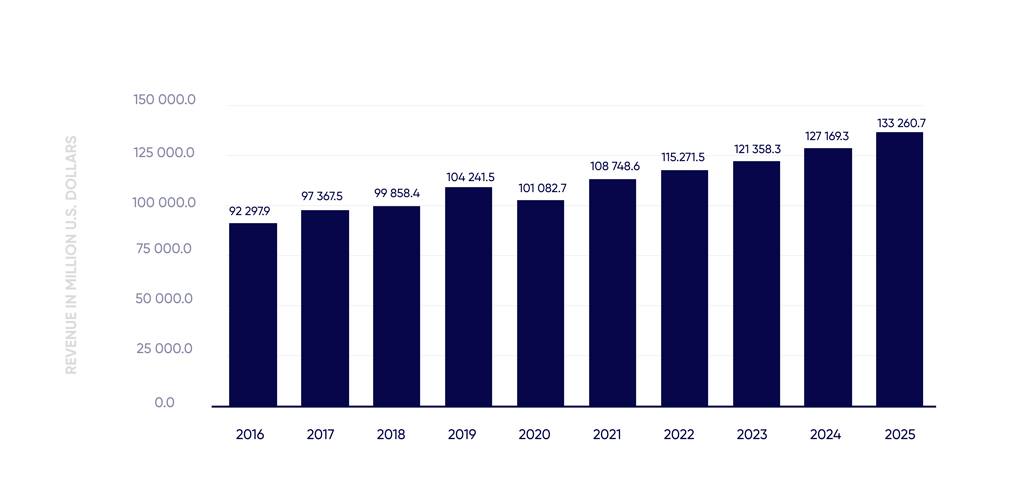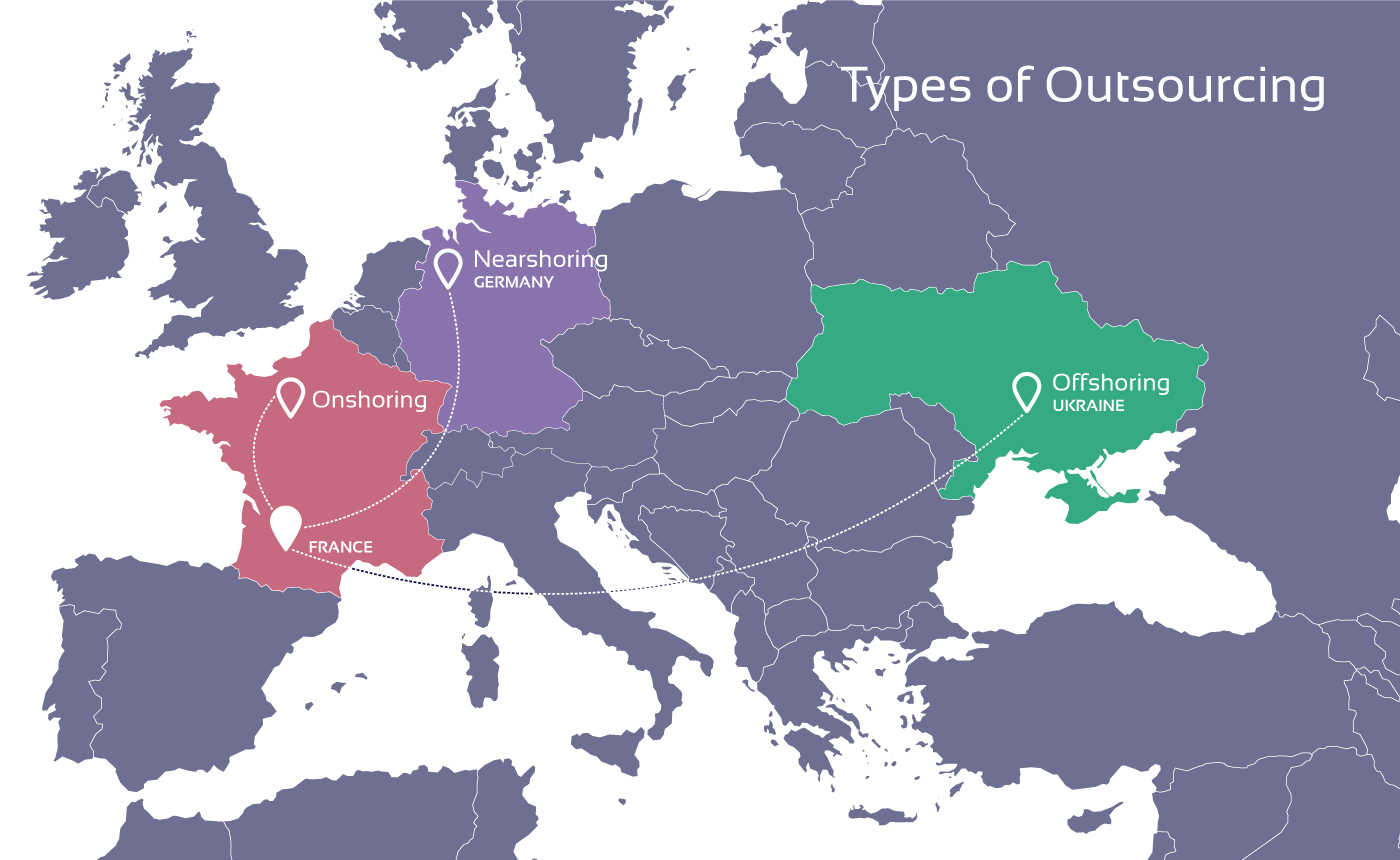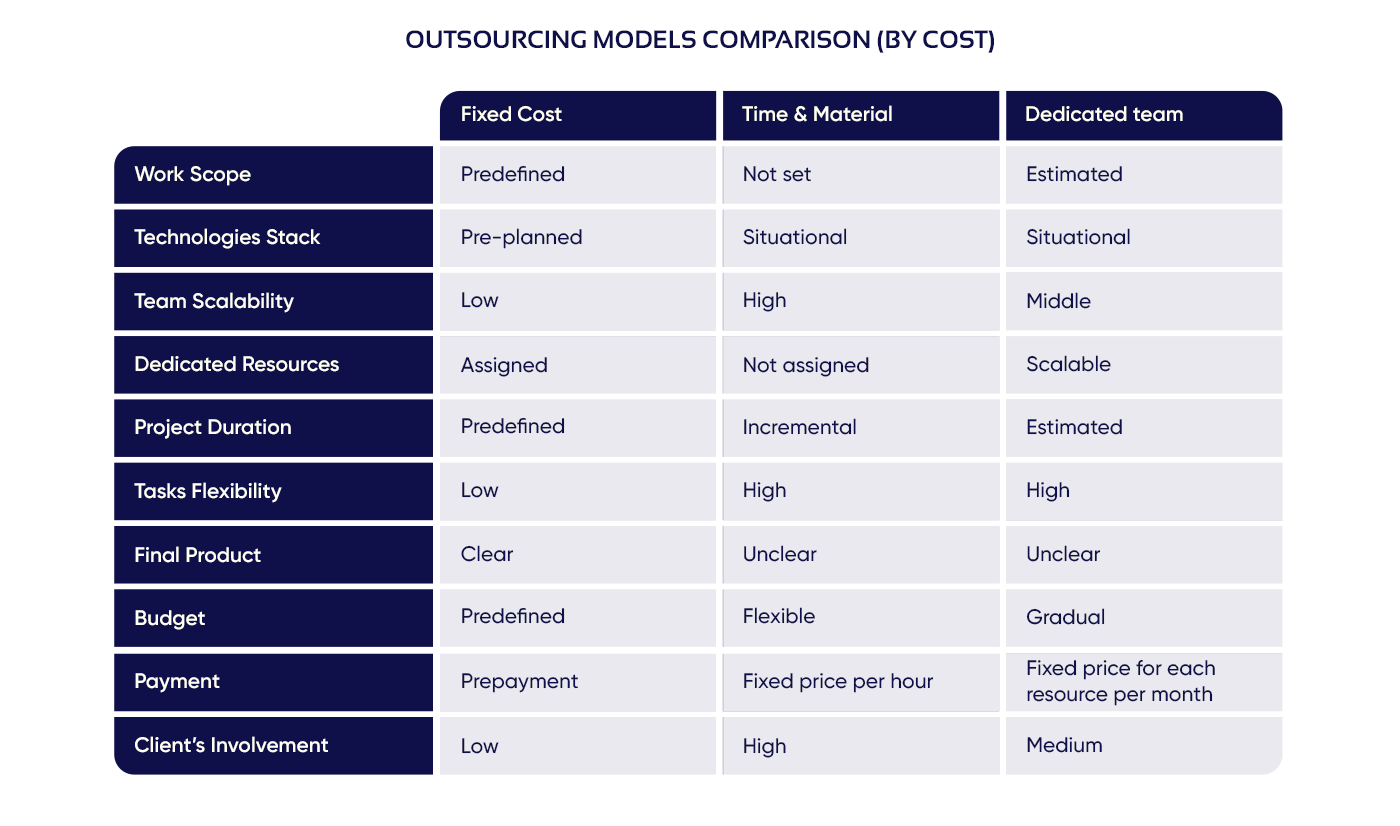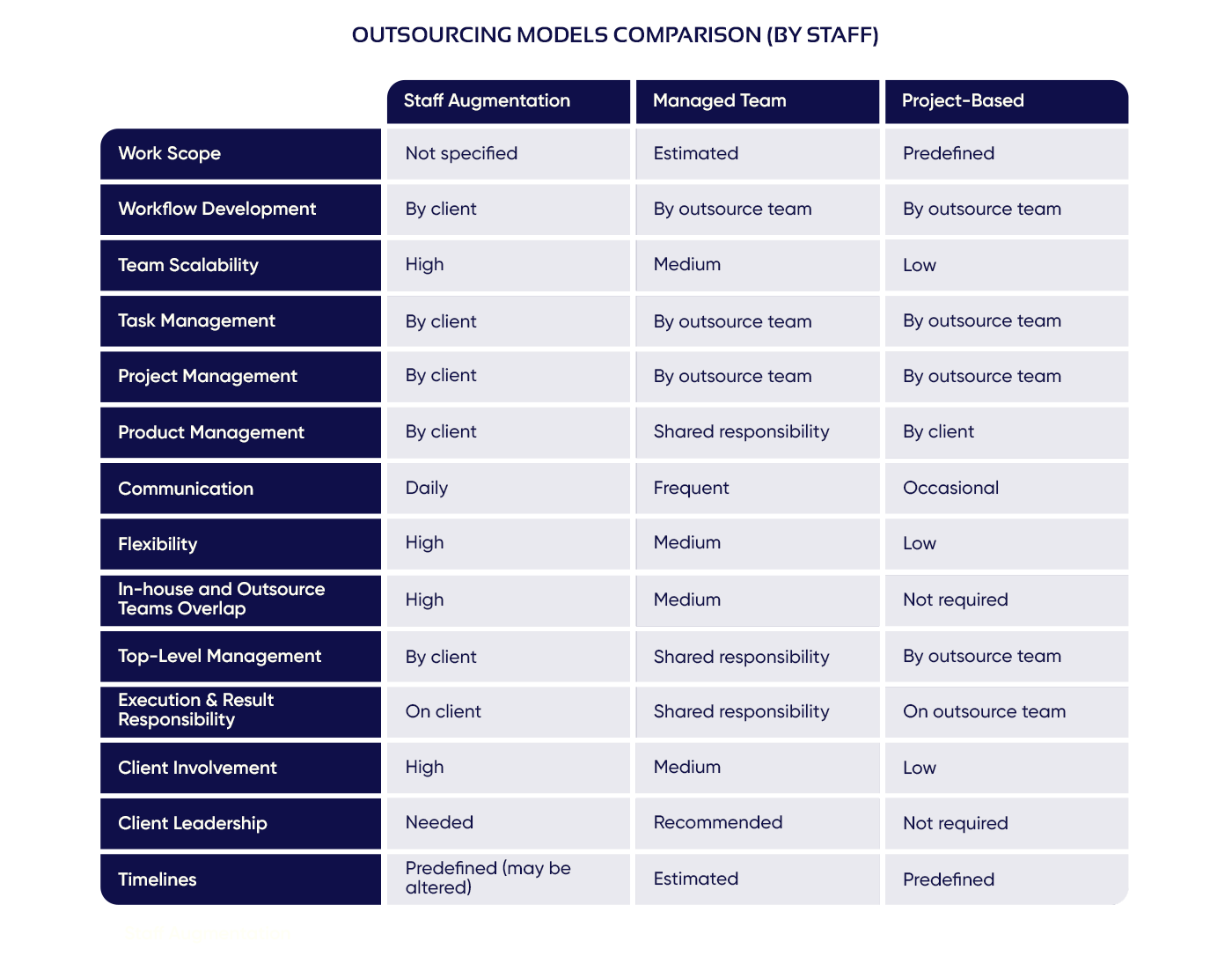IT outsourcing is an extensive practice among enterprises of all industries, structures, and sizes for a valid reason. Such practice is beneficial in many ways, and despite the fact that it has both advantages and disadvantages, opting for this approach is a better choice than creating your own tech or dev department. Especially if the business doesn’t require such services on a regular basis. On the other hand, if you’ve built a tech team, outsourcing some tasks can upgrade the skills of your experts and open new horizons for the whole company.
Outsourcing services have certain benefits and risks. However, the better development team you pick to work on your project, the more advantages you’ll get and the fewer risks you’ll face while cooperating. Below are the main reasons to choose a distant provider for application development outsourcing.
WHAT IS IT OUTSOURCING?
Information technology outsourcing means hiring a party outside (an outsource services provider or an experienced freelancer) to perform such services as consulting, software design and development (desktop, web, mobile), quality assurance, software maintenance, and support, etc.
Software outsourcing became a common business practice for companies all over the world. Many startups, as well as large corporations, have a long-term fruitful partnership with outsource/outstaff companies in different corners of the world. What’s worth your attention, is that 67% of companies state that they will continue following this approach.
According to Statista, the outsourcing services market will face a revenue increase each year, and by 2025, total revenue is anticipated to exceed USD 133B. That amount indicates that outsource development will be in even higher demand. The global pandemics had a considerable influence on those numbers as the multitude of businesses that didn’t even consider outsourcing in the past, now have to seek a trusted IT services vendor to handle an unstable economic backdrop.

Types of Software Outsourcing
Despite the variety of names, all types of outsourcing services have many things in common. They all imply hiring one person or a team that doesn’t belong to your business to deal with the chosen software or business tasks.
Determined by the distance, there are several most common types of IT services outsourcing:
Onshoring
Onshoring means trusting some IT services or other business issues to an outsource app development company located in the same city or country. The main benefit is a smooth interaction process between a company/client and a dev team.
Nearshoring
This type of IT outsource implies that either both companies are located in the same time zone or the difference does not exceed 2 hours. Commonly, physical proximity safeguards a cultural crossover share and guarantees other benefits for the company (e.g. similar or even shared legislation, currency like in case with the EU, etc.).
Offshoring
Usually, the time lag between business partners is 5 hours and more, and by choosing offshore software development, a company benefits from getting a good quality product at lower costs.
Multisourcing
Some may suggest: why choose only one approach? The answer is, you don’t have to. Many larger companies prefer not to put all eggs in one basket and diversify by applying multisourcing. Multisourcing strategy implies that the business owner works with several IT vendors simultaneously. The combination of IT outsourcing practices may vary. For example, the company leverages onshoring to ensure full control over the development cycle and at the same time hire a reliable offshore team to introduce the product to a new market as the locals have a better insight into their market.

Information technology services like software development and support depend on quality resources and the outcome stands upon the development team. Having a personal IT department is not a necessity and is more of a luxury, which is why numerous companies take any opportunity to outsource development, support, and other IT services.
IT OUTSOURCING MODELS
The moment you’ve decided to outsource the software development processes, you need to think of what model to choose to be sure it is the most profitable, productive, and cost-saving for your company. Outsourcing business models can be divided into cost and staff categories.
In case if you’re more interested in the financial side of outsourcing your processes, you can consider one of the following:
Fixed Cost Model
A fixed price agreement is pretty easy to comprehend: a customer pays an agreed amount of money and the contractor commits to deliver a certain agreed scope of work. The client is not allowed to change the requirements on the go and the contractor must not miss the due date or change the price of the IT outsourcing services.
When to opt for it?
This model offers your project many advantages as you receive exactly what you needed and no hidden payments or sudden delays appear along the way. However, cooperation on a fixed cost basis works only if you already have a detailed realistic specification and plan to make no changes. If you’re not sure which features to implement first or how the existing system will interact with the changes you plan to introduce, a fixed price contract is not for you.
Hourly/Time and Material Model
By far the most common IT outsourcing price model nowadays. The whole point of T&M pricing strategy is that the client pays exclusively for the hours the dev team spent delivering the tasks. Prior to the start of the development process, a business owner and the preferred contractor set the number of people working on the projects as well as define the hours each employee will work and the hourly rates. At the same time, the customer has the right to assign different tasks and change the scope of work (like adding new features or re-implementing the existing functionality) as well as ask the contractor to increase/reduce the number of specialists involved.
When to opt for it?
Since flexibility is an asset for any business, this approach will serve you perfectly if you know that your idea is innovative and raw. In this case, changes in workflow and a flexible budget won’t hurt your project. If you need to stop/pause the development, it is possible at any given moment.
Dedicated Resource Hiring Model
Unlike T&M outsourcing where you can buy an agreed amount of hours, the dedicated team model implies hiring a group of IT pros that engage exclusively in your project. Ergo, the service provider helps the consumer to get access to a fully functioning team (with account taken of the requirements and the project’s goals) and the specialists will spend their time working only on the customer’s tasks.
When to opt for it?
Complex projects need dedication from all engaged specialists. So if you’re looking for a lasting collaboration and plan to expand your project and business in general, this model will make you pleased with the efficiency.
See the financial IT outsourcing models comparison below:

Staff-oriented outsourcing models provide for a bunch of business fields and include:
Staff augmentation. Allows adding a professional to the team without spending time and internal recruiting resources.
Managed team. Get a team that specializes in a specific business or technical area, while you remain to be the center of decision making and other processes.
Project-based. Helps to get a fully-functional product without spending the company’s management resources on its development.
Take a glance at the comparison table of staff-oriented outsourcing models:

WHY OUTSOURCING IT: TOP BENEFITS
Cost Reduction. Delegating software development processes to a third party saves plenty of the company’s resources. The reason why organizations outsource a number of processes primarily lies in lower labor spendings and other money-saving benefits in the outsourcing location.
Time-Saving. The speed and quality paired up with saving money are among the main assets of outsourcing IT services. When your product is developed by skilled professionals, you don’t need to spend time seeking, hiring, and training people for the project. You just tell the third-party team what you want to get, and they start working with no delay.
You will get your product much quicker if you opt for hiring a good development team that includes QA and PM professionals as well as tech gurus.
Expertise. If you manage software product development outsourcing wisely, you can find real jewels in the field of IT. Skilled pros who are both talented and have enough experience to provide quality services in a shorter amount of time. Working with professionals is always a pleasure, isn’t it?
Advanced Vision & Insights. Since development teams create software for enterprises engaged in different industries, they look at the task from perspectives you don’t even know to exist. These specialists are very likely to bring valuable ideas into your software and make it unique as well as most efficient.
Fitting Technology Usage. Professionals always know what stack of technologies will be the best to choose for each project. Most importantly, they understand what technology should not be used to avoid hidden expenses occurrence in the long-term perspective. This reason is typically enough to answer the question “why outsource your IT services to a third party.”
New Perspective. Companies look at the future product only through the business objectives while any outsource development team will advise you to look at it from other perspectives as well. For example, software development specialists will point out flexibility flaws if they exist, check all features and logic from the user experience perspective, and can apply some changes based on predictive analytics.
Reduced Risks. When you know the software is developed by a team of professionals, it provides a sense of security. A business owner just knows every step will go smoothly during the dev stage and will stay smooth after the software is launched. The challenge to eliminate all low-cost software development risks is still there. However, if you outsource this business task to a team or a company instead of staying with only one freelance specialist, they will handle the majority of occurring problems by themselves. So, you will do nothing but enjoy the result of their work.
Quality Based on Motivation. Since software engineers are still in demand, they usually don’t lack projects. Therefore, the experts are motivated to finish the job as fast as it is physically possible. In addition, IT outsourcing professionals are motivated to create software products of the highest quality because once a company’s name is associated with quality, this reputation is very likely to work better than any advertising campaign.
In Tune with the Trends. New development technologies such as programming languages, libraries, frameworks, etc., appear too often. What was widely used a year ago may not be used tomorrow. By choosing a software product outsourcing, you get experts whose job is to be in tune with the existing and future trends. Most importantly, they understand where to use a well-known traditional technology, and where to apply a new one to achieve the best result possible.
OUTSOURCING IT: PROS AND CONS
Just like everything in this world, large, middle, and small business IT outsourcing has its perks and flaws.
The main benefits of outsourcing information technology services are:
- No need in hiring employees
- Lower labor costs
- Full control of expenses
- Access to innovative technology experts
- Risk mitigation
- Increase of focus on your core business processes
- Top-quality equipment
- Advanced knowledge database
- Professional advice on software optimization and improvement
- Upgraded project security
- Viable and marketable business product as a result
- Post-launch maintenance
However, the typical drawbacks of outsourcing software product development are:
- Communication problems (time zones, language skills)
- Hidden charges
- Problems with quality
- Possible differences in work approach
- Data theft risks
- Low development speed & quality
- Failure to keep up with the deadlines
While the mentioned reasons against trusting your IT worries to a software development outsourcing company are valid, they all are easy to eliminate. All you need is to choose a proper outsourcing model and get a well-prepared contract that will cover consequences for data theft, failure to complete tasks on time, inability to adjust the schedule to your timezone, etc.
WHY OUTSOURCE PROGRAMMING TO UKRAINIAN DEVELOPERS?
Specialists living in Ukraine are well-known for their hard work, dedication, and motivation to be among the best at what they do. Hundreds of skilled IT professionals can be found in any country, but consider these bullet-point reasons to choose the ones from Ukraine:
- A large number of highly-skilled specialists
- Low labor costs
- Extensive knowledge of English
- Time difference flexibility
- Constantly growing IT market in the area
- Steady and favorable economy
- A growing number of IT graduates, and more
In fact, IT has already become one of the key sectors of national economics. Around 36K of tech graduates are produced annually by more than 400 higher educational institutions. And what’s more important, the informational technology industry currently creates around 4% of GDP.
As BBC reports, Ukrainian IT startups have received USD 571 million worth of investments in 2020, which is a record. This means that investors see potential in the Ukrainian IT market even despite the pandemic.
If you ever were wondering if IT outsourcing to Ukraine will be worth it, check our newest piece regarding software outsourcing to Ukraine. It will definitely help you to get a better understanding on what to expect from the Ukrainian IT gurus.
TO CONCLUDE…
As a company that provides digital solutions across the globe, we offer you to check out our Case Studies to see why outsourcing IT tasks and services is definitely a smart idea for companies of all sizes. Among other things, a good reputation in business depends on the quality of software. That is why all digital compounds of your company must be user-friendly, bugless, and most efficient. If you need a website, a mobile application, a complex CRM platform, or any other digital product for internal or external use, don’t hesitate to contact us and get the one that would fulfill your company’s needs.




